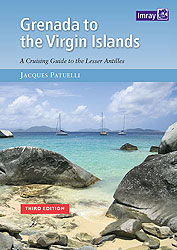| |
|

The island was discovered by Columbus
on 11th November 1493, St-Martin’s
Day. St-Martin was occupied by the
Spanish until 1644, in which year it was
conquered by Dutch forces commanded
by the Governor of Curaçao, Petrus
Stuyvesant, and French forces from St
Christopher. Four years later in 1648 the
island was split into two. Legend has it
that the border was drawn following a
walking race between a Dutchman
heading S and a Frenchman heading N
from Oyster Pond. Despite the rugged
terrain the Frenchman covered more
distance than the Dutchman, giving
France 3⁄5 of the 90sq km island. The
shrewd Dutch, however, got the salt
ponds of the S. Since then the division
has never been questioned, and, other
than during some English incursions in
the 18th century (finally ending in 1816),
the two flags have peacefully fluttered in
the same breeze for over three centuries.
Economically, salt from the salt ponds
was the major business of the Dutch for
a long time. Despite the dry climate and
arid soils, until the abolition of slavery,
which abruptly put an end to them, there
were also prosperous sugar cane
plantations. Despite a venture into cotton
growing and continuing exports of salt,
the island’s economy underwent a steady
decline. That lasted until the 1960s
when, especially in the Dutch half where
the international airport was built, the
tourism business started to grow.

Saint-Martin today (french side)
St-Martin’s new status should mean that
the island will no longer be attached to
the department of Guadeloupe. Despite
being a French dependency until recently,
St-Martin doesn’t actually have very
strong or deep French roots because most
of the French colonists left when slavery
was abolished. They were replaced by
Anglo-Saxon planters and a few Swedes
who rented their old estates. The slaves,
now free, had to assume a surname and
often took that of their new employers.
At the same time they adopted the
English language, in the process partly
turning it into a pidgin.
|
|
|
|
When agriculture
took a definitive downturn, the St
Martinois emigrated to the USA. Then
later on tourism to the island from N
America took off and the Anglo-Saxon
bent of the island increased.
 Consequently, although St-Martin is Consequently, although St-Martin is
French, names and language are mostly
English. The population these days is
75% black or mixed race Caribbean and
25% whites, mostly from mainland
France. Much as with Dutch St Maarten,
the French part of the island has turned
decisively towards developing the tourist
infrastructure along American lines.
Local taxation (or its absence) has
encouraged housing and hotel
developments, often in very kitsch styles,
to spring up all over the place. The local
council, mostly run by successive
generations of the island’s most
influential family, the Flemings, has
encouraged this spectacular trend. In the
past French St-Martin had often been
very frustrated by its dependence on
administrative decisions made in
Guadeloupe; now, however, its new
status should allow it more autonomy to
continue the intensive race to tourist and
property development, in line with what
the residents want. In fact, its free port
status, which has eased the way to the
inflow of capital and to its profitable
employment, has for a good number of
years now attracted the world of offshore
finance. The French authorities back in
Paris often speak of rethinking St-
Martin’s particular fiscal status. But at
present nothing is being done to risk
fracturing the dynamics of the island’s
economy, resting as they do on
recreational real estate development and
tourism.
Over the last few years the numerous
residential and hotel developments have
occasioned the arrival of more or less
clandestine immigrant workers, mostly
Haitians and Dominicans. The result has
all but doubled the resident population in
20 years. It follows that St-Martin has to
keep growing economically to avoid the
risk of a rise in unemployment and, as a
likely consequence, delinquency.
For better or worse, then, the ‘French
Side’ continues to be the nearest shop
window to the USA for luxury goods
with the ‘Made in France’ label, though
that doesn’t entirely compensate for the
absence of casinos.
|
|
|








 Consequently, although St-Martin is
Consequently, although St-Martin is